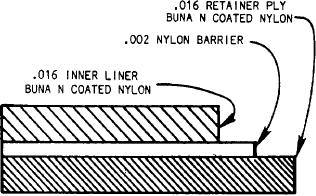
Buna-Vinylite lacquer to protect the cell from
spilled fuel and weathering.
Baffles and internal bulkheads are used inside
the cell to help retain the shape of the cell and
prevent sloshing of the fuel. They are constructed
of square woven fabric impregnated with Buna N
rubber.
Flapper valves are fitted to some baffles to
control the direction of fuel flow between
compartments or interconnecting cells. They are
constructed of Micarta, Bakelite, or aluminum.
These plies, baffles, internal bulkheads, and
flapper valves with the necessary fittings and
combinations make up a typical self-sealing fuel
Figure 4-6.-Bladder cell construction.
cell.
The nylon barrier consists of three to four
coats of nylon applied hot by brush, swab, or
Bladder-Type Fuel Cells
spray. The purpose of the nylon barrier is to keep
A nonself-sealing fuel cell is commonly called
fuel from diffusing through the cell wall.
a bladder-type cell. It is a fuel container that does
The retainer consists of Buna N coated square-
not self-seal holes or punctures. The advantage
woven fabric (cotton or nylon) or cord fabric. The
purpose of the retainer ply or plies is to lend
of using a bladder fuel cell results from the saving
in weight. Some of the other advantages are the
strength to the fuel cell and provide protection
simplicity of repair techniques and the reduced
for the nylon fuel barrier.
procurement costs over self-sealing fuel cells.
Bladder-type cells are usually made of very
NYLON-TYPE BLADDER CELL (PLIO-
CEL).-- Nylon bladder cells differ in construction
thin material to give minimum possible weight.
They require 100-percent support from a smooth
and material from the Buna N rubber cells. This
cavity. The cell is made slightly larger than the
type of cell may be identified by the trade name
cavity of the aircraft for better weight and
"Pliocel" stenciled on the outside of the cell. The
Pliocel construction consists of two layers of
distribution throughout the aircraft's fuel cavity
nylon woven fabric laminated with three layers
structure.
The thinner wall construction increases the
of transparent nylon film.
fuel capacity over the self-sealing cells, thus
The repair of this type of cell must be
increasing the range of the aircraft. Many of our
accomplished by entirely different methods and
with different materials. The adhesive and Buna N
aircraft that were formerly equipped with self-
rubber used to repair the rubber-type bladder cell
sealing cells have been changed to bladder-type
cells.
cannot be used on the nylon-type cell.
There are two types of bladder fuel cells--
EXTERNAL FUEL TANK
rubber type and nylon type.
SYSTEM DESCRIPTION
RUBBER-TYPE BLADDER CELLS.-- The
rubber-type bladder cells are made in the same
External fuel systems increase range or mission
manner as self-sealing cells. They have a liner,
by providing additional fuel for increased range
nylon barrier, and a ret airier ply. The sealant
or tanking. The external fuel system consists of
the fuel (drop) tanks, a transfer system and
layers are omitted. All three plies are placed on
jettison system.
the building form as one material in this order--
liner, barrier, and retainer. Figure 4-6 illustrates
Drop Tanks
this type construction.
The inner liner may consist of Buna N rubber,
Buna N coated square-woven fabric (cotton or
The 150- and 300-U.S. gallon Aero 1C and the
300-U.S. gallon Aero 1 D external fuel tanks
nylon), or Buna N coated cord fabric. The
are droppable, streamlined, metal containers
purpose of the inner liner is to contain the fuel
(fig. 4-7). These are carried under the wing to
and provide protection for the nylon barrier.
4-12

